6 EVERGREENS FOR THE GARDEN
Conifers certainly are evergreens, but not all evergreens are conifers. Break out of this woody rut with these gorgeous evergreens.
Small enough for urban gardens, these rare, native, flowering, fragrant or just plain interesting plants will bring unique interest to your garden.
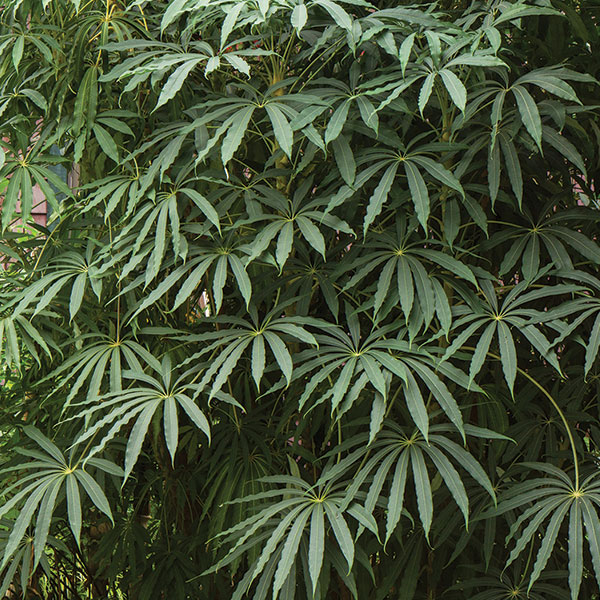
HARDY SCHEFFLERA
Schefflera taiwaniana ‘Yuan Shan’
Yes, A Hardy Schefflera
Also called an umbrella plant, this hardy species transcends scheffleras’ indoor-only reputation. Horticulturalist Dan Hinkley hand-collected this specimen high in Taiwan’s tropical cloud forest for propagation at his private Pacific Northwest nursery. Though native to steamy jungles, count on Yuan Shan to beautifully live through the Pacific Northwest’s four seasons.
GROWING GUIDE: Give moisture-loving schefflera a taste of home. Choose partial shade to full sun; establish in well-draining soil amended with leaves and humus. Protect from harsh sun in hot, dry summer areas. Water deeply and regularly during the first growing season to establish an extensive root system. Reaching 15 feet tall and wide, this palmate-leaved tree can be trimmed into shrub. It’s also a lovely container plant.
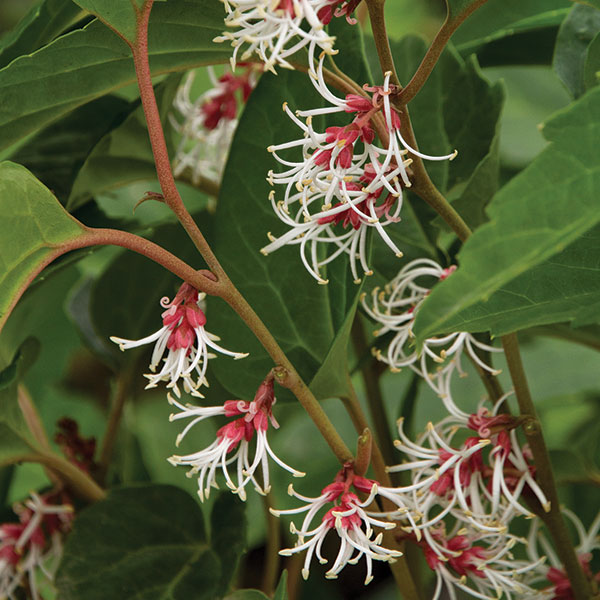
PACHYSANDRA
Pachysandra axillaris ‘Windcliff Fragrant’
So Nice It Blooms Twice
Another one of Hinkley’s rare finds, this glossy groundcover is anything but boring. Fragrant, spidery red-and-white blooms first erupt in early spring, and again in autumn. A slow-growing evergreen, P. axillaris spreads via rhizomes. A relative of boxwoods, this species is similarly durable.
GROWING GUIDE: Provide slightly acidic, well-draining soil. Prefers cool and shade with consistent moisture. Follow a regular watering schedule during the first growing season to establish a deep, extensive root system. As a groundcover, space plants three feet apart, closer for faster coverage. Control weeds with mulch until the plants cover the area. Reaches six inches tall.
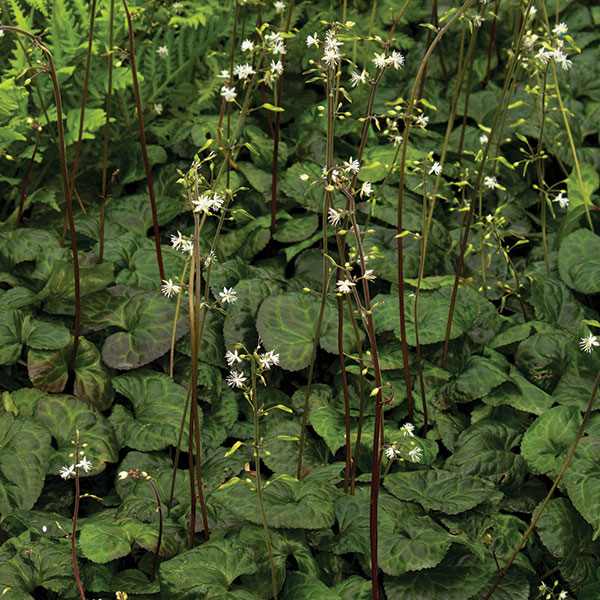
BEESIA
Beesia deltophylla
Made In The Shade
Hinkley first collected these beesia seeds from China in the 1960s. He returned 30 years later to hand-select this Sichuan Province groundcover. Hardy from New York to Normandy Park, its heart-shaped evergreen leaves are mottled lightly along veins. Spring brings new leaves in shades of purples and plums, along with dainty white flowers on foot-tall stems. This clumping shade lover is a favorite of hummingbirds and is deer resistant, too.
GROWING GUIDE: Establish in a sheltered, shady or very shady spot. Beesia thrives in humus-rich, well-draining soils. Follow a regular watering schedule the first growing season to develop a deep, extensive root system. Tolerates dry shade when established; best with regular moisture during hot, dry spells. Clip spent flower stems in late summer. Prune old foliage in early spring to rejuvenate. Reaches 18 to 24 inches tall.
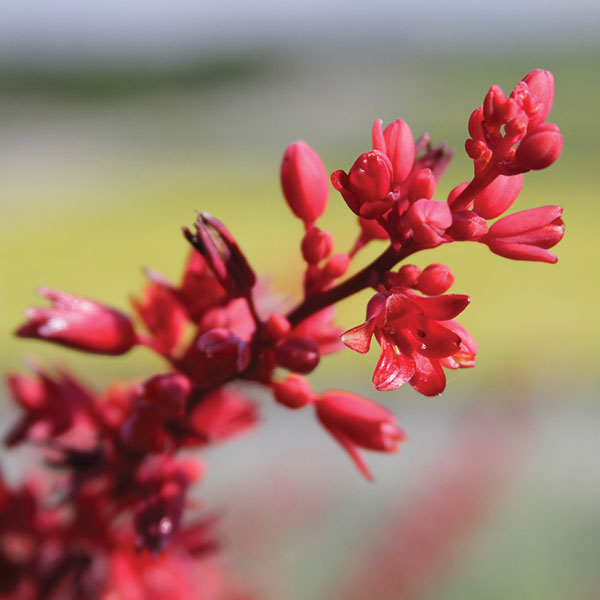
RED YUCCA
Hesperaloe parviflora ‘Brakelights®’
I Brake For Yucca
Native to the desert Southwest, red yucca is super-hardy clumping evergreen. It tolerates temps from scorching to sub-zero, and produces show-stopping flower spikes spring through fall, frequented by hummingbirds and pollinators. Fun fact: Red yucca isn’t a yucca at all—it’s a member of the Century Plant family, and is a cousin of tequila-rendering agave.
GROWING GUIDE: Grows easily in average to lean, well-drained soil. Follow a regular watering schedule during the first growing season to establish a deep, extensive root system. Apply a general purpose fertilizer before new growth begins in spring. Remove spent bloom stalks for a neat appearance. Reaches three feet tall and wide.
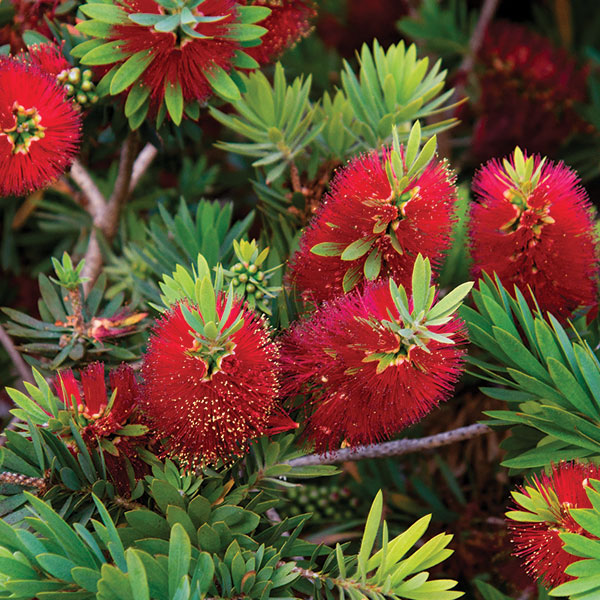
DWARF BOTTLEBRUSH
Callistemon citrinus 'Little John'
Citrus-scented Stunner
Aromatic leaves reminiscent of citrus plants give this blood-red bloomer its Latin name. Tolerating heat where others wilt, this colorful shrub beckons birds and bees with fiery blooms through summer. Its silky crimson flowers erupt along dense branches, which are covered with blue-green leaves.
GROWING GUIDE: Establish in full sun. Thrives in average, lightly acidic, well-drained soil; avoid alkaline soils. Water deeply, regularly during the first growing season to establish an extensive root system; reduce frequency once established. Apply fertilizer before new growth begins in spring. Prune to shape after flowering. Reaches three feet tall and five feet wide.
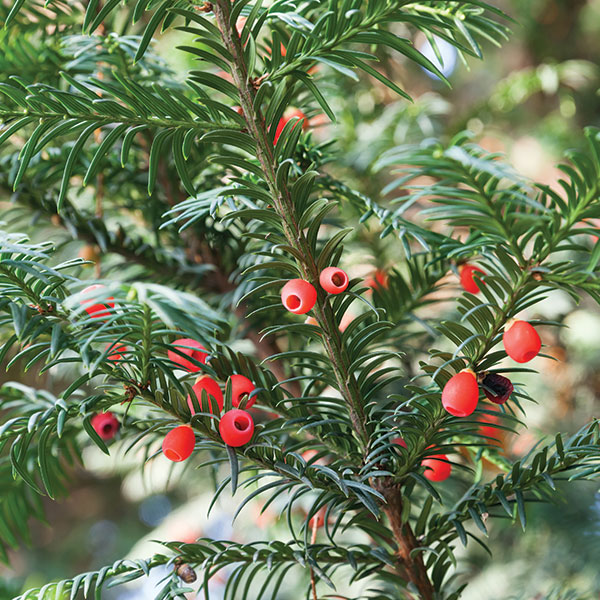
ENGLISH YEW
Taxus baccata spp.
Oh, It’s Yew
Some living yews are estimated to be older than 2,000 years, and you don’t live that long without a secret weapon. In the case of Taxus baccata, it’s poison. Every bit of a yew is toxic and could kill you, thanks to its fragrant terpenes called taxanes. Its taxanes are the main component of cancer-fighting drug Taxol.
GROWING GUIDE: Dry spells and standing water are a yew’s kryptonite, causing root loss or rot, respectively. Establish new plants in well-draining soil, and water regularly the first year—especially before extended dry periods. Use a good evergreen fertilizer in the spring. Prune at will—yews make terrific topiaries.

